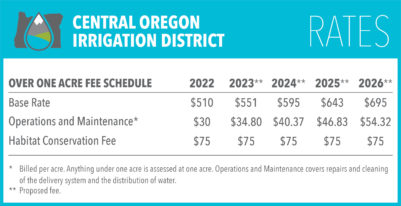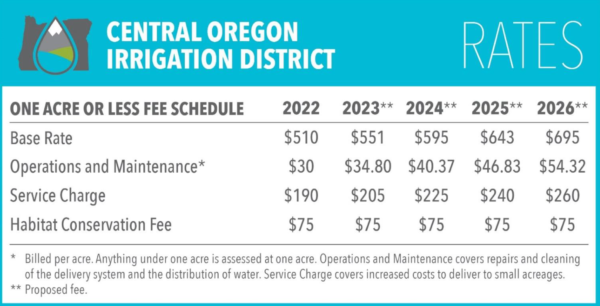OVER ONE ACRE FEE SCHEDULE:
Your bill is based on the following:
- Base Charges covers the cost of record-keeping, scheduling, insurance, office facilities, general administration, and overhead.
- Operations and Maintenance covers repairs and cleaning of the delivery system and the distribution of water • Service Charge covers increased costs to deliver to small acreages
- Habitat Conservation Plan Fee covers the cost-share of the Habitat Conservation Plan, as well as conservation and implementation measures to improve fish and wildlife habitat in the Deschutes Basin.

ONE ACRE OR LESS FEE SCHEDULE
Your bill is based on the following:
- Base Charges covers the cost of record-keeping, scheduling, insurance, office facilities, general administration, and overhead
- Operations and Maintenance covers repairs and cleaning of the delivery system and the distribution of water
- Service Charge covers increased costs to deliver to small acreages
- Habitat Conservation Plan Fee covers the cost-share of the Habitat Conservation Plan, as well as conservation and implementation measures to improve fish and wildlife habitat in the Deschutes Basin

2022 PLANNED RATE INCREASE
UPDATE: December 13, 2021
All COID patrons will see planned annual assessment (rate) increases between 2022 and 2026. The increases will help pay for irrigation district operation and maintenance costs and cover the administrative costs of servicing patrons. The new rate schedule will become effective January 1, 2022.
The District’s ability to provide reliable irrigation water depends greatly on having sufficient revenue, most of which comes from patron assessments. Since 2012 the District has been using hydropower to supplement increasing operations and maintenance costs and offset patron charges by as much as 40%.
Revenue for the hydropower industry has declined as companies shift renewable energy incentives and focus on wind and solar power. Our existing hydropower contract expired in 2020 with a five-year extension. When our rate extension ends, we expect hydropower revenue will plummet. By 2026, the District is anticipating a 60% revenue loss from hydropower. The lost hydropower funds that have supplemented operations and maintenance need to be replaced by patron assessments.
Despite increasing operating costs, the District has kept budget expenses nearly flat and reduced labor expenses by 12.9%. Even with these efforts, there is a need to stabilize long-term funding through increased assessments. The planned rate adjustments are based on a detailed rate study that provides a pricing structure and plans to meet COID’s long-term obligations.
Conservation projects, such as piping open canals, are primarily funded through state and federal grants and not through patron assessments.
QUESTIONS
If you have questions about the assessment changes, please contact Customer Service at 541-548-6047, Monday through Friday, 7 a.m. to 4 p.m.
